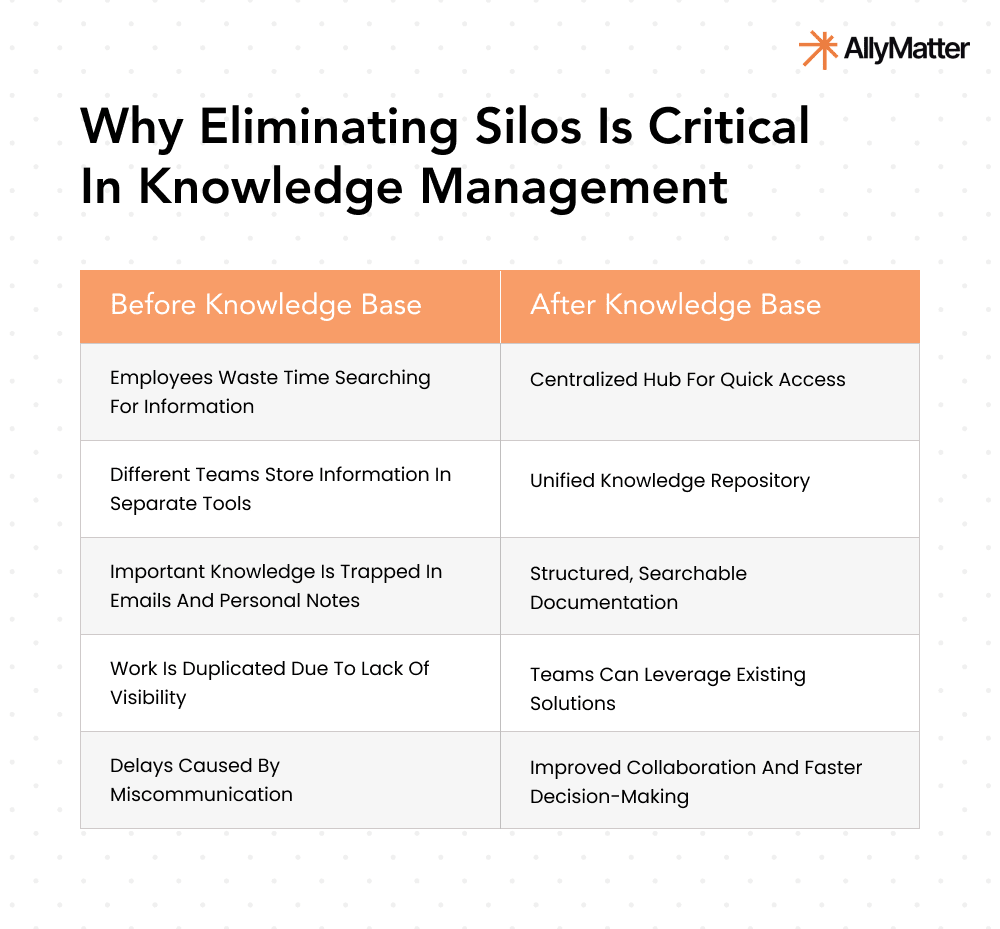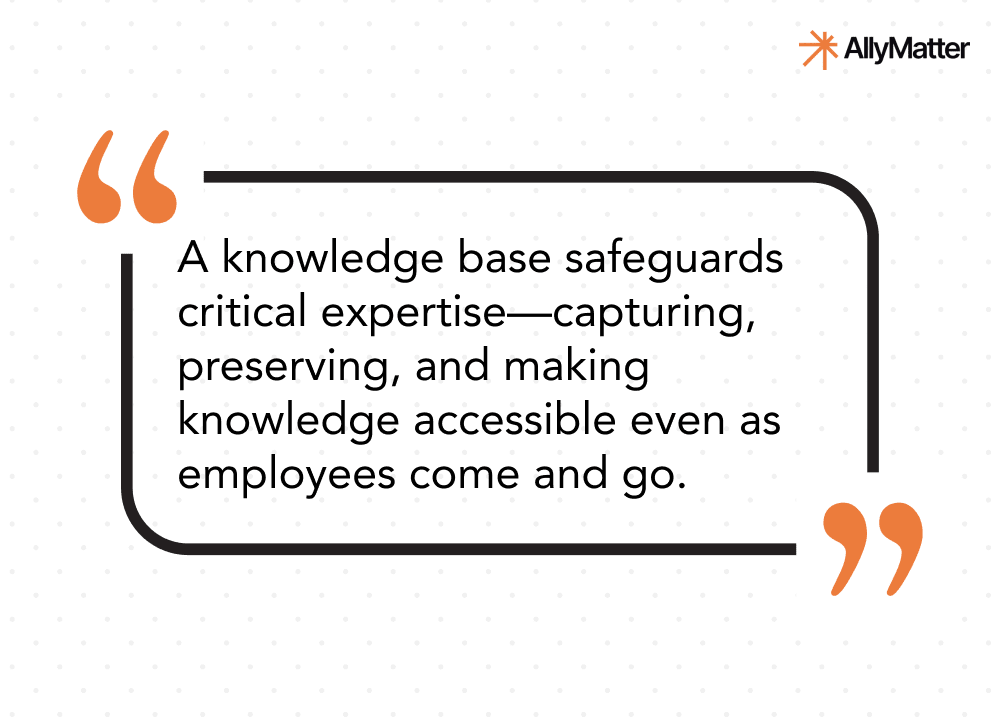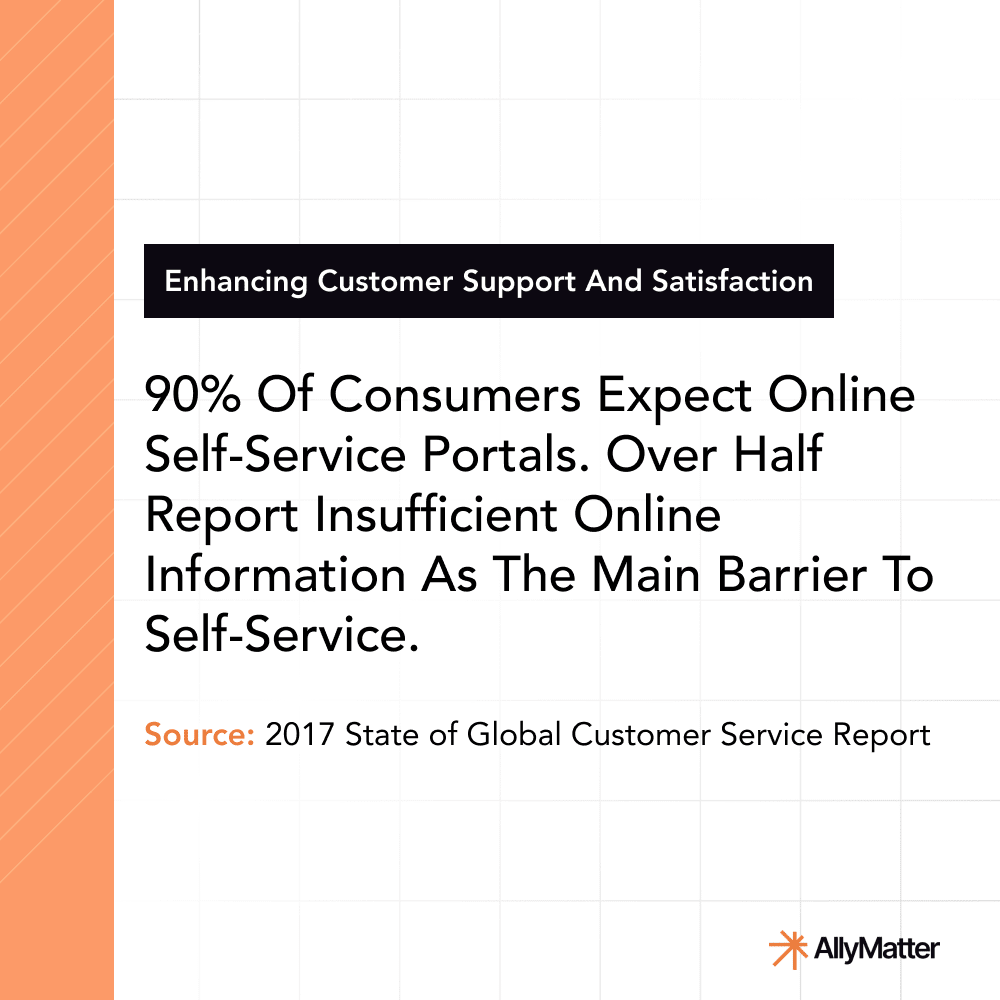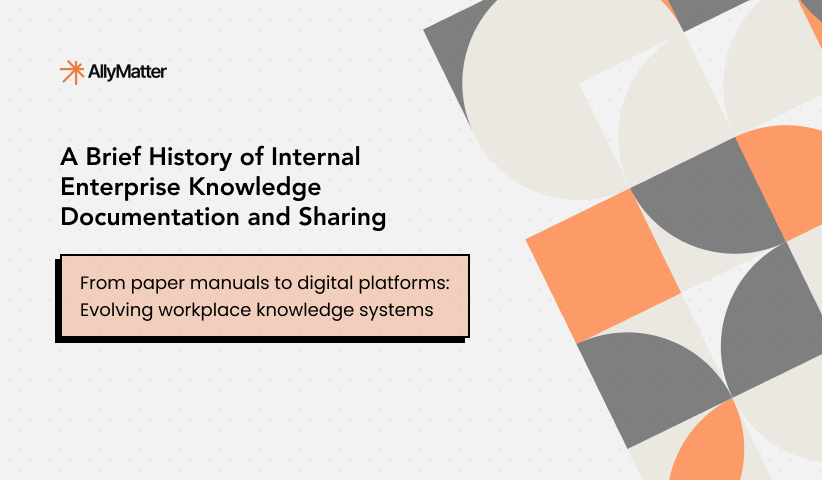Organizations generate an immense volume of information through daily operations – process documents, HR policies, customer support workflows, financial guidelines, and more. The challenge isn’t just creating this knowledge, but ensuring it’s accessible when needed.
Too often, critical information is buried in email threads, personal notes, informal chats, or siloed systems. This fragmentation leads to miscommunication, operational inefficiencies, and the risk of losing knowledge entirely when key team members leave.
To mitigate these issues, it’s essential to invest in a structured approach to knowledge management. A centralized knowledge base helps teams collaborate more effectively, reduces redundancy, and preserves institutional knowledge, supporting both daily productivity and long-term continuity.
Here are the key reasons why your organization needs a knowledge base and how it can drive success.
Eliminating information silos
Perhaps the most pervasive problem facing enterprises today is siloed information. When critical knowledge is trapped in departmental bubbles, email threads, or worse – individual employees’ minds – the entire organization suffers.
According to McKinsey research, employees spend nearly 20% of their workweek looking for internal information or tracking down colleagues for help, highlighting the critical need for centralized knowledge management.
This is not always a conscious decision but is driven by the tools that the department uses, their need for access and sometimes due to legal constraints or concerns. This leads to:
- Wasted time searching for information
- Duplication of work
- Miscommunication and delays

Consider this scenario: Your operations team develops an innovative process improvement, but the documentation lives solely in a spreadsheet on someone’s desktop. Meanwhile, another department struggles with the exact same challenge, unaware that a solution already exists within the company.
A knowledge base creates a centralized hub, ensuring that every department has access to up-to-date and relevant information.
Improving visibility & accessibility
Information must be both visible and accessible to be useful. Employees need access to essential knowledge for their roles, as well as supplementary information that enhances efficiency. A knowledge base ensures this by:
- Centralizing critical information for easy discovery.
- Reducing time spent searching for relevant data.
- Making both essential and helpful knowledge readily available.
A new member of the finance team would want to know the banking information to transfer money to a vendor, but the best way to do this is stored in a SOP document that the employee would not necessarily know even exists. The next challenge here is that the person knows that the SOP exists but does not have access to it because the IT administrator forgot to provide him access. This leads to inefficiencies and reduced productivity.
Enhancing cross-department collaboration
Beyond operational benefits, a well-implemented knowledge base fosters something even more valuable: collaboration and innovation. A centralized repository for information:.
- Enables real-time access to shared documents
- Reduces dependency on specific individuals
- Facilitates seamless knowledge sharing across departments
Thus, freely flowing knowledge can drive innovation and foster a culture of continuous improvement. For instance, a product development team might need insights from the marketing team about customer feedback trends. A shared knowledge base allows them to access these insights without waiting for interdepartmental meetings, promoting faster innovation cycles.
Standardizing processes for consistency
Inconsistent processes lead to inconsistent results. When different teams, departments, or locations develop their own methods for handling similar tasks, quality suffers, efficiency declines, and risks increase.
A knowledge base ensures that everyone follows the same set of guidelines, reducing variability and enforcing best practices across the organization. This leads to:
- More consistent quality in service and operations
- Increased efficiency by eliminating redundant or conflicting approaches
- Better risk management through standardized compliance and documentation
For example, if a customer service team has multiple ways of handling refund requests, it can create confusion and customer dissatisfaction. A centralized knowledge base with standardized response templates ensures uniform service quality, improving customer experience and internal efficiency.
Preserving knowledge & preventing loss
Employee turnover presents another significant risk to organizational knowledge. When key personnel leave, they take years of institutional knowledge with them, unless it’s documented. Research from Panopto shows that 42% of institutional knowledge is unique to individual employees and isn’t documented elsewhere in the organization.
A knowledge base helps by:
- Capturing tribal knowledge before it’s lost
- Documenting critical processes for continuity
- Ensuring smooth transitions when employees retire or resign

For example, a senior project manager with years of experience managing complex client projects leaves the company. Along with them goes valuable knowledge about best practices, past lessons, and unique problem-solving approaches. Without proper documentation, new project managers struggle to fill the gap, leading to inefficiencies and repeated mistakes. A well-maintained knowledge base captures and preserves this expertise, ensuring seamless transitions, reducing disruptions, and empowering new project managers who step into the role.
Enabling faster onboarding & training
Hiring and training new employees can be expensive and time-consuming. According to the Society for Human Resource Management, it takes new hires 8-12 months to achieve full productivity in professional roles.
Without standardized documentation, new hires rely on colleagues for guidance, slowing down the onboarding process. A knowledge base solves this by:
- Providing structured training materials for easy learning
- Reducing onboarding time with step-by-step guides
- Ensuring consistent training across teams
This not only accelerates productivity but significantly reduces the burden on existing team members who would otherwise need to pause their work to conduct training.
For instance, a new sales representative might need to familiarize themselves with product details, pricing structures, and CRM usage. Instead of waiting for a manager to schedule training sessions, they can access relevant onboarding documents and tutorials from the knowledge base, enabling them to start contributing faster.
Supporting continuous learning & development
Most training in a business environment is a one-time activity, which isn’t enough; people forget, and processes evolve. People are trained when they join or learn how to perform a task once or twice on the job with a mentor or manager present. A knowledge base supports ongoing learning and minimizes errors.
- Step-by-step guides provide quick refreshers.
- Searchable training resources help employees learn on demand.
- Real-time updates keep knowledge relevant.
For instance, an IT technician trained on security protocols might remember the initial training but forget specific troubleshooting steps, leading to mistakes that compromise security. Managers may not have time to retrain employees regularly. A centralized knowledge base provides updated resources for employees to access as needed, ensuring continuous learning without overburdening management.
Scaling information effortlessly
As organizations expand, so does the volume of information and the number of employees or customers needing access to it. A knowledge base scales effortlessly, ensuring:
- Consistent information delivery without excessive costs
- A structured approach to managing increasing data
- Seamless adaptation to business growth
For example, a startup might initially use emails and shared drives for information sharing. As it expands into multiple offices across regions, these methods become inefficient. A centralized knowledge base allows all employees, regardless of location, to access the same updated content seamlessly.
Read more: Scaling Knowledge Done Right through Internal Knowledge Bases
Supporting remote and hybrid models
With the rise of hybrid and remote work, employees need instant access to critical information. When employees can’t simply walk to a colleague’s desk for answers, having a robust knowledge base becomes essential as it enables:
- Self-service support for employees, reducing reliance on internal help desks
- Round-the-clock access to important documentation
- Better collaboration across geographies and time zones
As flexible work arrangements become permanent for many organizations, the value of centralized, accessible knowledge continues to grow.
Read more: Effective Knowledge Sharing for Remote & Asynchronous Teams
Enhancing customer support and satisfaction
A robust knowledge base isn’t just for employees; it also enhances customer experience. A comprehensive knowledge base allows customers to find answers to their questions without needing to contact support, thereby:
- Enabling quick resolution of customer queries through self-service portals
- Providing consistent answers across support channels
- Reducing customer wait times and frustration
This reduces the number of support tickets and freeing up customer service teams to focus on more complex issues.

For example, a tech company might receive repeated questions about common troubleshooting issues for their software. By creating a detailed knowledge base with step-by-step guides, customers can resolve these issues themselves, leading to quicker resolutions and improved customer satisfaction.
Meeting compliance and legal standards
Maintaining a centralized and up-to-date repository of policies, procedures, and guidelines helps ensure employees follow legal and regulatory requirements, reducing compliance risks. A knowledge base supports this by:
- Centralizing policies and guidelines for easy reference.
- Keeping documentation updated to reflect the latest regulations.
- Ensuring audit readiness with organized, trackable records.
For example, a healthcare company may need to ensure that all employees follow updated HIPAA regulations. A knowledge base containing clear, up-to-date procedures helps ensure that everyone complies, minimizing legal risks.
Leveraging data for smarter decision-making
A knowledge base isn’t just about storing information; it also provides valuable insights that help organizations improve efficiency and address gaps proactively. Many modern knowledge base tools offer analytics features that show:
- Which articles are accessed most frequently
- What questions are users are asking
- Where information gaps exist
This data can inform decisions about training, process improvements, and content updates. For example, an HR department might notice that employees frequently search for information on the company’s remote work policy. This could indicate a need for clearer communication or additional resources to address remote work guidelines.
Centralize your knowledge with AllyMatter
AllyMatter transforms scattered company expertise into an organized, searchable knowledge repository. Our platform provides the granular access control, audit trails, and approval workflows that growing companies need to maintain security while enabling knowledge sharing.
With features like version control, smart search, and role-based permissions, AllyMatter ensures your team can find critical information instantly while maintaining compliance and data security. Whether you’re standardizing HR processes or preserving technical documentation, AllyMatter scales with your organization’s knowledge management needs.
Knowledge as competitive advantage
A knowledge base isn’t just a repository; it’s a strategic asset. In an era where information overload is common, the ability to capture, organize, and deploy knowledge effectively becomes a significant competitive advantage. Organizations that prioritize knowledge management gain a competitive edge by fostering innovation, improving decision-making, and ensuring sustainable growth.
More importantly, they create environments where valuable insights don’t get lost in the noise – where your team’s collective intelligence becomes your most powerful asset. In today’s knowledge economy, can your organization afford to operate any other way?
Frequently asked questions
What is the difference between a knowledge base and a wiki?
A knowledge base is a structured repository designed for storing and accessing company information with controlled permissions and approval workflows. A wiki is more collaborative but typically lacks the enterprise-grade security, version control, and granular access management that growing companies need for sensitive documentation.
How do you measure the success of a knowledge base?
Track metrics like search success rates, time to find information, employee self-service rates, and content usage analytics. Most organizations see improvements in onboarding time, reduced support tickets, and increased employee satisfaction when knowledge is easily accessible.
What types of content should go in a knowledge base?
Include standard operating procedures, HR policies, compliance documentation, training materials, troubleshooting guides, and any information teams reference regularly. Focus on content that multiple people need access to rather than personal notes or temporary documents.
How often should knowledge base content be updated?
Review critical content quarterly and update immediately when processes change. Set up automated reminders for policy reviews and assign content owners to ensure accuracy. Outdated information can be worse than no information at all.


